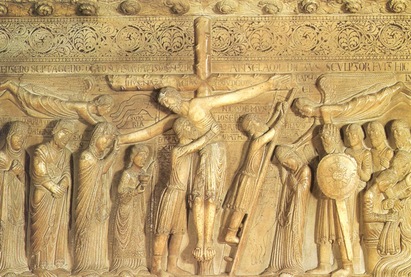Venite Ad Aquas

Tuesday Within the Fourth Week of Lent
Ezechiel 47:1-9, 12
Psalm 45:2-3, 5-6, 8-9
John 5:1-16
All You That Thirst
Today’s texts are just waiting to be developed into a pre-baptismal catechesis. “All you that thirst, come to the waters: and you that have no money come, and drink with joy” (cf. Is 55:1). The Entrance Antiphon is addressed to all who thirst; there is nothing to purchase. The waters flow freely. The last phrase of the antiphon — “drink with joy” — is not found in the biblical text. It is the Church’s word, making clear for us here and now, the prophecy of Isaiah.
Flowing Waters
The Responsorial Psalm sings of the river that irrigates the Church, the new Jerusalem: “The city of God enriched with flowing waters, is the chosen sanctuary of the Most High” (Ps 45:5). The Communion Antiphon praises Christ the Shepherd who, in the Eucharist, “leads us by refreshing waters” (cf. Ps 22:1-2). In the Gospel we see the waters of Bethesda, a bath of healing stirred by an Angel of the Lord. All around the pool of Bethesda lie the diseased, the blind, the lame, and the disabled seeking to recover from the infirmities that oppress them. Bethesda is an image of the baptismal pool of regeneration, the bath from which in a few weeks the catechumens will emerge clean, healed, and altogether new.

Vidi Aquam
The centerpiece of today’s Mass is the reading from the prophet Ezekiel. The title printed in red above the text in the lectionary is most unusual. It reads: “I saw water flowing from the temple, and all who were touched by it were saved.” It adds, “See Roman Missal.” Where in the Roman Missal are we to look? Go to the antiphons sung at the Rite of Sprinkling with Holy Water: the Asperges me, taken from Psalm 50, and used outside of Paschaltide; and the Vidi aquam, taken from Ezekiel 47, and sung at the Paschal Vigil and on the Sundays of Paschaltide.
Look for a moment at the text of the Vidi aquam. The prophet Ezekiel, in a mystical rapture, sees the Temple as the wellspring of an immense river irrigating the whole country and making stagnant waters fresh. The Temple is the abode of the Glory of God (Ez 43:1-12). It is the source of a river, teeming with fish, and on both sides of its banks grow fruit bearing trees because the water for them flows from the sanctuary.
The glorious body of the crucified and risen Christ is the new and indestructible temple of which he himself said, “Destroy this temple and in three days I will raise it up” (Jn 2:19). At the death of Christ, the veil of the Temple was “torn in two from top to bottom” (Mt 27:51); Saint John, by recounting how the side of Jesus was pierced by the soldier’s lance, translates the same mystery. Out of the pierced Heart of Jesus flows blood and water (Jn 19:34), recalling the water from the rock struck by the rod of Moses in the desert (Num 20:2-13), the fountains of salvation prophesied by Isaiah (Is 12:3), and the great river of Ezekiel’s vision.
Christ’s Open Heart
Speaking in 2006, Pope Benedict XVI said, “I am counting on you to see to it that our common endeavour to fix our gaze on Christ’s open Heart will hasten and secure our path towards the full unity of Christians.” The Holy Father was saying, in effect, that the Church, born of the pierced side of Christ, will be restored to unity by returning to her place of origin in his Sacred Heart. The contemplation of the open Heart of Christ is, for all of us, the means by which we recover the interior unity fragmented by sin. One born spiritually of the pierced side of Christ can be renewed in the graces of its birth only by returning, consciously, deliberately, and corporately to that pierced side. The water and blood that flow from the open Heart of Jesus bring new life and fecundity to those who hold themselves beneath the Cross, to those who immerse themselves in the saving torrent.
We Little Fish
The Fathers identify the water flowing from the side of Christ with the water of Baptism. According to Tertullian, this is the water teeming with little fish, the newly baptized: “But we, little fish, who hold our name from our icthus Jesus Christ, we are born in water, and it is only by remaining there that we are saved.”
The Source of Love
The fruit-bearing trees on both sides of the river represent all who are “rooted in love, founded on love” (Eph 3:17). The Church is “like a tree planted by streams of water, that yields its fruit in due season” (Ps 1:3). There is no vitality, no fruitfulness, apart from the source. In Deus Caritas Est, Pope Benedict XVI says precisely this: “Anyone who wishes to give love must also receive love as a gift. Certainly as the Lord tells us, one can become a source from which rivers of living water flow (cf. Jn 7:37-38). Yet to become such a source, one must constantly drink anew from the original source, which is Jesus Christ, from whose pierced heart flows the love of God (cf. Jn 19:34).”
Heart of Jesus, Wellspring of Life
Today’s signs of the Temple, the pierced side of Christ, and the font of holy Baptism reveal a single mystery, and in the Eucharist, we are reconnected with all three signs. Drink anew from the original source. Return to the place of your birth: the open Heart that is, that was, and that ever shall be the wellspring of life.
